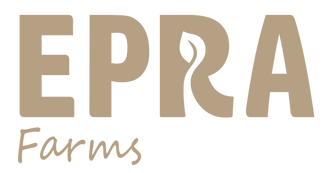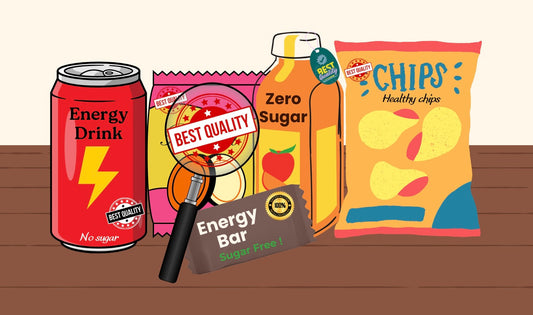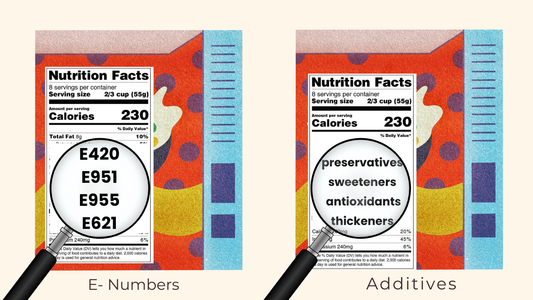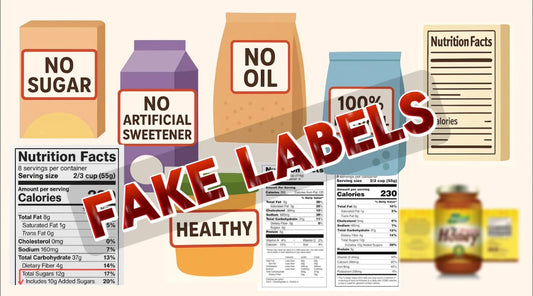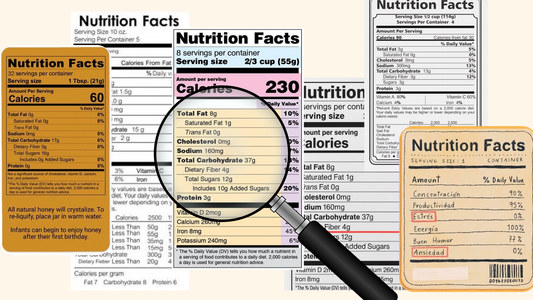The Sweetest Lie in the Supermarket
Walk through a supermarket aisle and you’ll spot it everywhere:
-
“No Added Sugar” juices.
-
“No Added Sugar” biscuits.
-
“No Added Sugar” energy drinks.
It’s one of the most powerful phrases in food marketing because it makes you feel instantly safe: “Oh good, this won’t harm my blood sugar, this won’t make me gain weight.”
But here’s the uncomfortable truth: “No Added Sugar” almost never means sugar-free.
👉 It usually means the company didn’t add table sugar - but they added other sweeteners, concentrates, syrups, or high-sugar ingredients that behave the same in your body.
This blog will decode what “No Added Sugar” really means, why it’s misleading, and how to spot the tricks.
Chapter 1: The Technical Definition
By FSSAI and international food law:
-
“No added sugar” = the manufacturer didn’t add sucrose (table sugar), glucose, or fructose during processing.
But the loophole is wide open:
-
They can use fruit juice concentrate.
-
They can use maltodextrin, corn syrup, jaggery, or honey.
-
They can use high-calorie ingredients like dates or raisins for sweetness.
👉 The result: the product still spikes blood sugar - it just avoids the word “sugar” on the label.
Chapter 2: How the Trick Works
Example 1: Fruit Juice
Front label: “No Added Sugar.”
Back label: Water + fruit concentrate + stabilizers.
Reality: Fruit concentrate = concentrated sugar water. One glass has ~25 g sugar - same as cola.
Example 2: Biscuits
Front: “No Added Sugar.”
Back: Wheat flour, palm oil, invert syrup, jaggery.
Reality: Jaggery = sugar in disguise.
Example 3: Energy Bar
Front: “No Added Sugar.”
Back: Dates + raisins + glucose syrup + oats.
Reality: Still 20 g sugar per bar, just from “natural” sources.
Chapter 3: Why It’s Misleading
When people see “No Added Sugar,” they assume:
-
The product is safe for diabetics.
-
The product won’t cause weight gain.
-
The product is naturally sweet and healthy.
But reality is:
-
Calories remain the same.
-
Blood sugar still spikes.
-
Dental risk still exists.
-
Diabetics are still at risk.
👉 “No added sugar” = marketing comfort, not metabolic truth.
Chapter 4: The Natural Sugar Halo
Brands exploit the fact that Indians trust “natural” sweeteners.
-
Jaggery: Marketed as “desi and healthy,” but glycemic index higher than sugar.
-
Honey: Marketed as Ayurvedic, but 80% sugar.
-
Dates/Raisins: Marketed as natural, but calorie-dense and sugar-heavy.
So if a biscuit is sweetened with jaggery or dates, it can legally say “No Added Sugar.” But your blood sugar doesn’t care about the label - it still spikes.
Chapter 5: The Diabetic Trap
This is the most dangerous part.
-
Many diabetics switch to “no added sugar” products thinking they’re safe.
-
But fruit concentrates, jaggery, and honey still push blood sugar up sharply.
-
Studies show these “natural” sugars can raise glucose faster than refined sugar.
👉 For diabetics, “no added sugar” often means false hope.
Chapter 6: How to Decode “No Added Sugar”
Here’s how you protect yourself:
-
Flip the pack. Ignore the front.
-
Check the ingredients. Look for fruit concentrate, jaggery, honey, glucose syrup.
-
Check sugar per 100 g.
-
<5 g = low sugar.
-
5–10 g = moderate.
-
10 g = high sugar.
-
Check the total carbs. If sugar is hidden, carbs will still be high.
-
If it tastes sweet, it’s sweet. Labels don’t change biology.
Chapter 7: Case Studies from Indian Shelves
Juice Box
Front: “No Added Sugar. Made with Real Fruit.”
Back: 10% fruit concentrate + water.
Sugar: 24 g per glass.
👉 Same sugar as cola, but marketed as healthy.
Health Biscuit
Front: “No Added Sugar. High Fiber.”
Back: Wheat flour, jaggery, invert syrup.
Sugar: 20% by weight.
👉 Still a cookie.
Protein Bar
Front: “No Added Sugar. High Protein.”
Back: Dates, raisins, glucose syrup.
Sugar: 18–20 g per bar.
👉 More sugar than protein.
Chapter 8: The Honest Alternatives
If you truly want sugar-free:
-
Look for monk fruit or stevia sweetened products.
-
Check that maltodextrin or sorbitol aren’t hidden.
-
Or best, stick to whole fruits, nuts, and clean-label snacks.
At EPRA Farms, we keep it simple:
-
Monk fruit extract + erythritol.
-
No jaggery, no concentrates, no “no added sugar” games.
-
Transparent label, clean ingredients.
👉 Because “no added sugar” should mean exactly that: zero added sugar.
Chapter 9: FAQs
Q: Is “no added sugar” juice safe for kids?
A: No. It still has as much sugar as soft drinks. Whole fruit is safer.
Q: Is “no added sugar” safe for diabetics?
A: No. Fruit concentrate, honey, and jaggery spike glucose.
Q: Is “no added sugar” always bad?
A: Not always - but check the nutrition table. If sugar per 100 g is high, it’s unhealthy.
Conclusion: What It Really Means
“No added sugar” is one of the biggest half-truths in food marketing. It doesn’t mean sugar-free. It doesn’t mean diabetic-safe. It doesn’t mean low-calorie.
👉 It simply means the company avoided table sugar - but found other ways to make it sweet.
The only defense is awareness:
-
Flip the pack.
-
Read the numbers.
-
Learn the aliases.
And when you want real sweetness without sugar games? That’s where monk fruit comes in.
